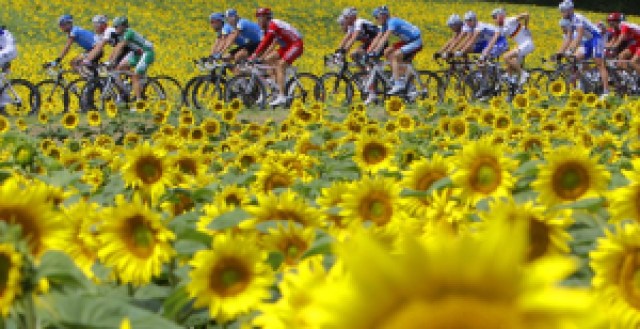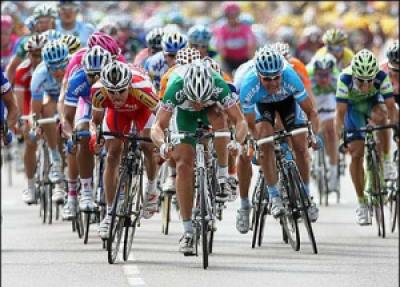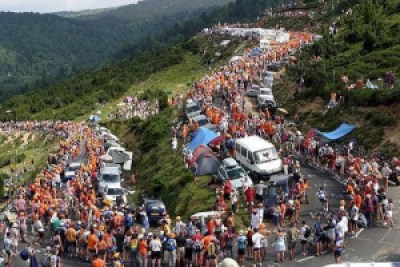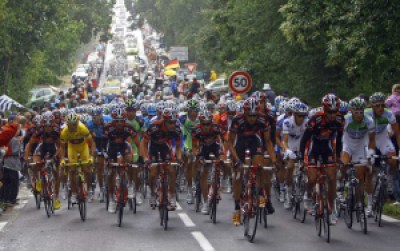Each of the 21 stages of the 2010 Tour de France is in actuality an individual race and for each of the 21 stages there will be a winner. In fact, there could be 21 different winners. However, only one rider will win the Tour and become the 2010 Tour de France champion. Each day of the Tour (minus the two rest days) will feature a stage race, but the competition for the overall race (GC or general classification) is what the serious contenders compete for.
To give you a better idea of how this all plays out in the actual Tour let’s look at a rider and his team. You may have heard of a rider by the name of Lance Armstrong.
Lance rides on Team Radio Shack this year. He is their lead rider, the captain if you will, the rider that the team feels has the best chance of winning the Tour or at least finishing high up in the GC or in some teams’ case, competing for the sprinter’s (green) or climber’s (polka dot) jersey.
As the leader, every resource of Team Radio Shack is there to support Lance and give him the best chance to win or place high in the GC. During the flat stages (sprint stages) teammates will ride around him to shelter him from wind and accidents. They will also get him food, water or anything else he needs. During the flat stages, the goal of the team is to protect Lance and to make sure at the stage finish he is in the lead peloton (and thus gets the same finish time as the other contenders that are safely tucked away in the peloton with him).
The Tour is not won on the flat stages, but as Phil Liggett and Paul Sherwen (Phil and Paul are the voices of cycling – the Howard Cosell’s of the professional cycling world) are quick to point out – it can be lost on the flats due to crashes and silly mistakes.
Armstrong will never take a pull at the front or work for another rider as long as he is in contention for the overall race – it’s not his job. The domestiques on the team do that work, as well as get him water or food from the team car that follows behind the peloton. As we move into the mountain stages a different group of teammates (climbers) will support him by setting the pace and allowing him to draft and conserve energy, plus protect him from accidents, etc. Again, someone in this group makes sure he has what he needs – water/food. Typically in the tough mountain stages (with the HC or beyond category climbs) Lance will end up at some point on the climb alone (with no teammates) competing against the other teams top GC men – mano a mano.
The Tour will be decided either in the high mountains or the individual time trial. To win the Tour de France a rider has to be able to climb and time trial well. Some riders can do one of those well, only a select few do both well. Those few are the riders that have a legitimate chance to win the Tour.
It will be interesting to see how it plays out. Barring accidents, drug test failures or other calamities the winner of the Tour will be decided between 3 maybe 4 riders. Of course, one of those guys getting hurt, losing a significant chunk of time, or sustaining a significant injury changes everything. And those things happen, so who knows.
Who will win:
The favorite has to be the pistol saluting Alberto Contador; the young Spaniard and winner of last year’s and 2007 Tour. Contador was Lance’s teammate last year (and I use the word teammate loosely – they did not like each other). Contador climbs effortlessly, time trials well and is young. Armstrong could also win. Obviously he climbs well, time trials well, but for a professional cyclists he’s pushing the calendar at age 38. But he is such a competitor, I wouldn’t count him out.
Then there are the Schleck brothers, Andy and Frank. Andy finished 2nd in last year’s Tour and he just keeps improving. There is also Cadel Evans, a complete rider who has had a good year with a new new team, so he could be up there, as could Americans, Christian Vande Velde and Levi Leipheimer. There are other riders, Bradley Wiggins for one, that have the talent and skill to win the Tour. The odds are it will be Alberto Contador (his team isn’t that strong, but with his youth and skills it may not matter), but Lance looked awfully strong in the Tour de Suisse coming in 2nd to Frank Schleck. With a strong team behind the Schlecks you can’t count them out either. By the time we get to the difficult mountain stages we should have a good idea of who is in contention to win it all.
The difficult mountain stages are toward the end of the Tour, followed by the individual time trial, culminating in the processional into Paris for the coronation of the 2010 Tour de France Champion.




